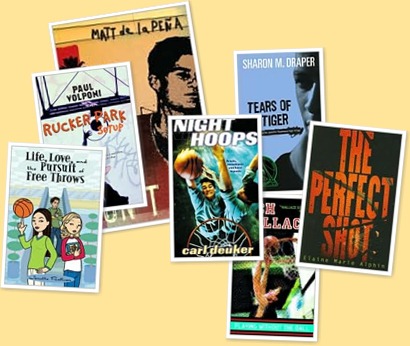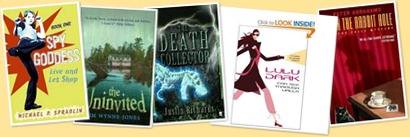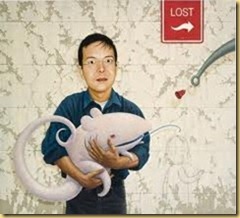As I was reading over my review of Flip, I remembered how much I liked it, and I thought, “Hmmm…why don’t I use this for this month’s book?” So, here you go. For the review, see below.
An online club for teens to talk about books, movies, TV shows, music, magazines and video games
Sunday, October 16, 2011
Wednesday, October 5, 2011
Review of Flip by Martyn Bedford
Alex wakes up one morning after a night out, and he’s in a strange bed in a strange house. Someone is shouting for him from downstairs, but they’re calling, “Flip!” He’s sure it’s just some kind of mix-up, until he gets his first look in a mirror and doesn’t recognize the person he sees. How did he end up in someone else’s body? Can he get anyone to believe that he isn’t who they think he is? And what happened in the 6 months since his last memory as the old Alex, and his first memory as Flip? About the only one who knows that Alex isn’t Flip is the Garamond family retriever, Beagle, who growls at him each time he sees him. Alex is confused and desperate, but, at the same time, he’s kind of fascinated by his new life and family. There are some great things about being Flip (being popular at school is one. Having any number of girlfriends is another), but he’d rather be himself again. Flip’s family and friends are bewildered by his new habits (really his old habits), and it’s funny to watch Alex having to deal with a body that doesn’t work the same way his own does. When he abandons cricket and hanging out with his crude friends, his buddies are really worried. Then he falls for a sensitive, intelligent girl. Alex finds other people on the internet who have experienced what they call psychic evacuation –when a soul leaves a body and enters another body, usually because of the imminent death of their own body. I’ve watched lots of movies that involve people swapping bodies, but it’s always with someone they know. It’s really intriguing to watch Alex try to navigate a life as someone he’s never met, and surrounded by people he doesn’t know. There’s plenty of suspense as Alex tries to figure out why his soul took over Flip’s body, and how he can get back into his own before it’s too late. Review by Stacy Church
Wednesday, September 21, 2011
Want To Read More Books Like Me, the Missing, and the Dead?
Here are some more books about life going on after a death in the family
Defining Dulcie by Paul Acampora
Boy2girl by Terence Blacker
Feels Like Home by e. E. Charlton-Trujillo
A Swift Pure Cry by Siobhan Dowd
The Key to the Golden Firebird by Maureen Johnson
Let's Get Lost by Sarra Manning
Girlhearts by Norma Fox Mazer
After the Wreck, I Picked Myself up, Spread My Wings, and Flew away by Joyce Carol Oates.
Cures for Heartbreak by Margo Rabb
A Gathering of Shades by David Stahler, Jr.
Broken Soup by Jenny Valentine
Tuesday, September 6, 2011
Jenny Valentine
Here’s what Harper Collins Publishers has to say about Jenny Valentine, author of Me, the Missing, and the Dead:
Jenny Valentine worked in a food shop for fifteen years, where she met many extraordinary people and sold more organic bread than there are words in her first book. She studied English literature at Goldsmith's College, which almost made her stop reading but not quite. Her debut novel, Me, the Missing, and the Dead, won the prestigious Guardian Children's Fiction Prize in the UK under the title Finding Violet Park. Jenny is married to a singer/songwriter and has two children. She lives in Hay on Wye, England.
When asked in an interview by The Bookbag what her inspiration for the book was, Valentine said:
Ah, well I knew a lady called Eileen when I was nineteen and she was about eighty. She was the first disgracefully behaved old lady I had ever met and I thought she was brilliant. When she died she was cremated and her ashes were left on a shelf - not a mini cab office - but somewhere very odd. The difference is I don't think Eileen minded, but Violet does.
Saturday, August 20, 2011
This Month’s Book: Me, the Missing, and the Dead by Jenny Valentine

- Speak like they think teenagers speak (always wrong, excruciatingly wrong).
- Get drunk too quickly or too much.
- Be rude to people they don’t know.
- Flirt with your teacher and your friends..
- Forget their age.
- Use their age against you.
- Get piercings.
- Wear leather trousers (both sexes).
- Drive badly (without admitting it).
- Cook badly (ditto).
- Go to seed.
- Sing in the shower/car/public.
- Don’t say sorry when they’re wrong.
- Shout at you or each other.
- Hit you or each other.
- Steal from you or each other.
- Lie to you or each other.
- Tell dirty jokes in front of your friends.
- Give you grief in front of your friends.
- Try to be your mate when it suits them.”
As I’ve already hinted, by the end of the book, Lucas has solved more than one mystery, and has come to some sort of peace with the world, and his mother especially. Review by Stacy Chur
Saturday, June 11, 2011
What Inspired Chris Wooding To Write The Haunting…?
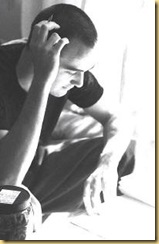 The story came out of the scenery really. I had just moved to London from Leicester (where I’d returned after Uni in Sheffield), and I absolutely hated it. I just couldn’t get on with the Underground, the unbelievable amount of time it took to get anywhere, the sheer size and riotous expense of the place. The dark, perpetually foggy and dangerous city in the book was just an exaggeration of what I felt, and the rest fell out from there. It started as a riff on how much I disliked living in London, mixed in with a bunch of H.P.Lovecraft that I was heavily into at the time, and somewhere along the line it developed subtext, themes and even, dare I say, a message. –from http://www.chriswooding.com
The story came out of the scenery really. I had just moved to London from Leicester (where I’d returned after Uni in Sheffield), and I absolutely hated it. I just couldn’t get on with the Underground, the unbelievable amount of time it took to get anywhere, the sheer size and riotous expense of the place. The dark, perpetually foggy and dangerous city in the book was just an exaggeration of what I felt, and the rest fell out from there. It started as a riff on how much I disliked living in London, mixed in with a bunch of H.P.Lovecraft that I was heavily into at the time, and somewhere along the line it developed subtext, themes and even, dare I say, a message. –from http://www.chriswooding.com
Friday, June 3, 2011
This month’s book: The Haunting of Alaizabel Cray by Chris Wooding
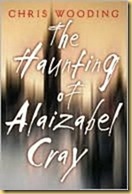 This is a very creepy book. It's set in London in what appears to be the 19th century, but none of the events described in the story have any real place in history. In this parallel London, the city was bombed and nearly destroyed by a German airship fleet, and in the ensuing years becomes overrun by wych-kin, supernatural monsters that prey on human beings. The only protection comes from wych-hunters who use ancient rituals to track them and kill them. Thaniel Fox is a 17-year-old wych-hunter who learned the craft from his father, and then his mentor, Cathaline. The book opens with Thaniel chasing a Cradlejack (much more dangerous than it sounds: it's like a vampire that preys on babies) into an abandoned building where he stumbles across a crazed young woman who attacks him and then collapses. He takes her home, and with Cathaline's help, tries to unravel her mystery. The only thing she remembers is her name: Alaizabel Cray. Cathaline surrounds her room with talismans to ward off any evil pursuers, but Alaizabel insists that during the night something cold, wet and horrible tried to get into her room, even though no one else heard or felt anything. Is she insane or is something really trying to get her? Thaniel and Cathaline soon realize that the girl they saved is the key to a conspiracy that could bring the ultimate evil into the world. Along the way, they join forces with the vagrants, pickpockets and other unsavory people who inhabit the Old Quarter, an area of London most people avoid. Besides the wych-kin and wolves that inhabit the Old Quarter, there's also the serial killer Stitch-face, clearly modelled on Jack the Ripper. This is a real page-turner, but don't read it unless you have a strong stomach for gore. Review by Stacy Church
This is a very creepy book. It's set in London in what appears to be the 19th century, but none of the events described in the story have any real place in history. In this parallel London, the city was bombed and nearly destroyed by a German airship fleet, and in the ensuing years becomes overrun by wych-kin, supernatural monsters that prey on human beings. The only protection comes from wych-hunters who use ancient rituals to track them and kill them. Thaniel Fox is a 17-year-old wych-hunter who learned the craft from his father, and then his mentor, Cathaline. The book opens with Thaniel chasing a Cradlejack (much more dangerous than it sounds: it's like a vampire that preys on babies) into an abandoned building where he stumbles across a crazed young woman who attacks him and then collapses. He takes her home, and with Cathaline's help, tries to unravel her mystery. The only thing she remembers is her name: Alaizabel Cray. Cathaline surrounds her room with talismans to ward off any evil pursuers, but Alaizabel insists that during the night something cold, wet and horrible tried to get into her room, even though no one else heard or felt anything. Is she insane or is something really trying to get her? Thaniel and Cathaline soon realize that the girl they saved is the key to a conspiracy that could bring the ultimate evil into the world. Along the way, they join forces with the vagrants, pickpockets and other unsavory people who inhabit the Old Quarter, an area of London most people avoid. Besides the wych-kin and wolves that inhabit the Old Quarter, there's also the serial killer Stitch-face, clearly modelled on Jack the Ripper. This is a real page-turner, but don't read it unless you have a strong stomach for gore. Review by Stacy Church
Friday, May 27, 2011
Favorite Quotes from The Edenville Owls
“In bad weather, especially when it was raining and windy, I used to like to go down to the empty bandstand and sit in it alone, protected by the pointed roof, and look at the way the rain and the wind made the harbor look.” (page 23)
“There was something in his voice, like a piece of broken glass.” (page 31)
“I wondered if it was a sin to think about her with her clothes off. I hoped it was only a venial sin. I mean, guys thought about stuff like that.” (page 33)
“Well, so far I’ve lied and broken my word and skipped school and broken into Miss Delaney’s house,” I said “I mean, am I a good guy or a bad guy?” (;age 108)
Tuesday, May 24, 2011
Review of Unearthly by Cynthia Hand

Sunday, May 8, 2011
Review of The Running Dream by Wendelin Van Draanen
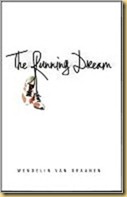 It’s hard to find any word other than inspirational to describe Van Draanen’s book about a 16-year-old runner whose leg has to be amputated after her track team’s bus is involved in a terrible accident. Jessica goes through all the stages you would expect a teen (or anyone else) to go through, but the author moves the story along, focusing just the right amount on the difficulties she faces. Her parents are just as devastated as she is, but they manage to hide from Jessica the financial trouble they are in because of the school’s attempt to deflect responsibility. After Jessica goes back to school, her track coach shows her YouTube videos of runners with prosthetic legs, and she begins to think that maybe she can run again after all. The cost is prohibitive, but the team is determined to raise the money, and even convinces Jessica to let herself be photographed in shorts, showing her temporary prosthesis, which looks like a pipe. There’s a side story of Jessica becoming friends with a girl in her math class who has cerebral palsy Jessica has always looked right through her before, but now that she has to share her table in the back of the room, realizes that she is a smart, funny math genius. Like everything else in the book, this could come off as cliched, but Van Draanen pulls it off. This is a great story of how someone’s life can go on after a terrible tragedy, and in fact can be even better than before. Review by Stacy Church
It’s hard to find any word other than inspirational to describe Van Draanen’s book about a 16-year-old runner whose leg has to be amputated after her track team’s bus is involved in a terrible accident. Jessica goes through all the stages you would expect a teen (or anyone else) to go through, but the author moves the story along, focusing just the right amount on the difficulties she faces. Her parents are just as devastated as she is, but they manage to hide from Jessica the financial trouble they are in because of the school’s attempt to deflect responsibility. After Jessica goes back to school, her track coach shows her YouTube videos of runners with prosthetic legs, and she begins to think that maybe she can run again after all. The cost is prohibitive, but the team is determined to raise the money, and even convinces Jessica to let herself be photographed in shorts, showing her temporary prosthesis, which looks like a pipe. There’s a side story of Jessica becoming friends with a girl in her math class who has cerebral palsy Jessica has always looked right through her before, but now that she has to share her table in the back of the room, realizes that she is a smart, funny math genius. Like everything else in the book, this could come off as cliched, but Van Draanen pulls it off. This is a great story of how someone’s life can go on after a terrible tragedy, and in fact can be even better than before. Review by Stacy Church
Friday, May 6, 2011
Review of Ghostopolis by Doug TenNapel
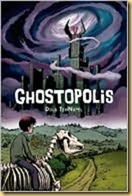 Here I am writing reviews of two horror books in a row, when I don’t usually like horror. Well, this one is a graphic novel, so there’s more to appeal to me than with the usual horror story. I found this book really charming. The story begins with Frank Gallows, a sort of has-been ghost catcher who tracks down ghosts who have snuck back to earth from the afterlife, accidentally zapping Garth Hale into the ghost world when he was trying to capture a living dinosaur skeleton. Frank zaps both of them, and Garth names the dinosaur “skinny” and rides him around the afterlife trying to escape other marauding dinosaurs, and eventually the evil Vaugner who has taken over the rule of the afterlife with the help of some giant bugs. Ok, it sounds ridiculous, and the story is much too confusing to try to explain, but the artwork is great, there’s romance, suspense, lots of gory fights and killing…what more could you ask for in a graphic novel? Review by Stacy Church
Here I am writing reviews of two horror books in a row, when I don’t usually like horror. Well, this one is a graphic novel, so there’s more to appeal to me than with the usual horror story. I found this book really charming. The story begins with Frank Gallows, a sort of has-been ghost catcher who tracks down ghosts who have snuck back to earth from the afterlife, accidentally zapping Garth Hale into the ghost world when he was trying to capture a living dinosaur skeleton. Frank zaps both of them, and Garth names the dinosaur “skinny” and rides him around the afterlife trying to escape other marauding dinosaurs, and eventually the evil Vaugner who has taken over the rule of the afterlife with the help of some giant bugs. Ok, it sounds ridiculous, and the story is much too confusing to try to explain, but the artwork is great, there’s romance, suspense, lots of gory fights and killing…what more could you ask for in a graphic novel? Review by Stacy Church
Review of Three Quarters Dead by Richard Peck

Want To Read More Novels about Basketball?
Try one of these:
The Perfect Shot by Elaine Marie Alphin
In These Girls, Hope Is a Muscle by Madeleine Blais
On the Devil's Court by Carl Deuker
Night Hoops by Carl Deuker
Tears of a Tiger by Sharon M. Draper
Jump Ball: A Basketball Season in Poems by Mel Glenn
Rebound by Bob Krech
Hoops by Walter Dean Myers
Slam! by Walter Dean Myers
Game by Walter Dean Myers
Ball Don't Lie by Matt de la Peña
Life, Love, and the Pursuit of Free Throws by Janette Rallison
The Hoopster by Alan Lawrence Sitomer
Black and White by Paul Volponi
Rucker Park Setup by Paul Volponi
Playing without the Ball: A Novel in Four Quarters by Rich Wallace
Friday, April 29, 2011
Review of The Poison Diaries by Maryrose Wood
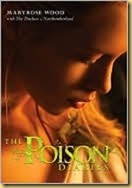 I have to say I’m not sure how I feel about this one. I liked the beginning: Jessamine keeps a diary of her lonely life with her father in a remote cottage in Northumberland. Her father, Thomas Luxton, isn’t a doctor, or a butcher (what he calls surgeons), but when people are sick, they send for him He is called an apothecary, but he considers himself a gardener, nevermind that many of the plants he grows are poisonous. In fact, he has a special walled garden that’s kept locked, which is full of all varieties of poisonous plants. Jessamine’s life changes when the local owner of an insane asylum drops off a strange, orphaned teenaged boy who’s accused of curing the inmates of their madness. It’s hard to believe that in that time period (late 18th century?) Jessamine’s father would have left her alone in the cottage for days at a time with a boy her own age, but it’s more believable when you realize later in the story that he has nefarious plans for them. Thomas Luxton would give anything to learn ancient secrets of healing plants that have been lost through the ages, and it appears that the foundling boy, Weed, somehow has that knowledge. The story gets pretty wild, but it’s certainly suspenseful. I would have to call this a fantasy since the plants talk to weed, and Prince Oleander, the Prince of Poison, is masterminding it all. Review by Stacy Church
I have to say I’m not sure how I feel about this one. I liked the beginning: Jessamine keeps a diary of her lonely life with her father in a remote cottage in Northumberland. Her father, Thomas Luxton, isn’t a doctor, or a butcher (what he calls surgeons), but when people are sick, they send for him He is called an apothecary, but he considers himself a gardener, nevermind that many of the plants he grows are poisonous. In fact, he has a special walled garden that’s kept locked, which is full of all varieties of poisonous plants. Jessamine’s life changes when the local owner of an insane asylum drops off a strange, orphaned teenaged boy who’s accused of curing the inmates of their madness. It’s hard to believe that in that time period (late 18th century?) Jessamine’s father would have left her alone in the cottage for days at a time with a boy her own age, but it’s more believable when you realize later in the story that he has nefarious plans for them. Thomas Luxton would give anything to learn ancient secrets of healing plants that have been lost through the ages, and it appears that the foundling boy, Weed, somehow has that knowledge. The story gets pretty wild, but it’s certainly suspenseful. I would have to call this a fantasy since the plants talk to weed, and Prince Oleander, the Prince of Poison, is masterminding it all. Review by Stacy Church
Review of Trash by Andy Mulligan

Saturday, April 23, 2011
Review of Bamboo People by Mitali Perkins

Friday, April 22, 2011
Review of Life, After by Sarah Darer Littman
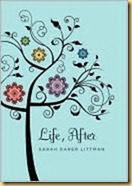 Life, After is a window into a culture and time period that I knew almost nothing about –Argentina during “the Crisis" in the late 1990’s, when the nation’s banks failed. People left Argentina after losing everything, many of them were Jews who emigrated to Israel, or the US. Dani’s home life is miserable –her mother works long hours at the hospital to try to support the family after they lost the family business. Her father is depressed, and only comes out of his depression to yell at Dani and her younger sister. Her aunt died in a terrorist bombing when Dani was 7, and her father has never gotten over it. Dani’s best friend left for Israel. She does have a boyfriend (her novio), but his family decides to move to Miami. After Dani’s mother was injured in a protest outside her hospital, she finally convinces Dani’s father that they should move to America, too. Although some parts of the story seem too pat (how quickly Dani makes new friends and finds a new boyfriends in America, and how her dad’s depression lifts so completely once he decides to take medication), I really enjoyed Life, After for it’s portrayal of what life in Argentina was like –the food, the political history, the family values, and the difficulties Dani faces as she tries to fit into a new school in a new country. Review by Stacy Church
Life, After is a window into a culture and time period that I knew almost nothing about –Argentina during “the Crisis" in the late 1990’s, when the nation’s banks failed. People left Argentina after losing everything, many of them were Jews who emigrated to Israel, or the US. Dani’s home life is miserable –her mother works long hours at the hospital to try to support the family after they lost the family business. Her father is depressed, and only comes out of his depression to yell at Dani and her younger sister. Her aunt died in a terrorist bombing when Dani was 7, and her father has never gotten over it. Dani’s best friend left for Israel. She does have a boyfriend (her novio), but his family decides to move to Miami. After Dani’s mother was injured in a protest outside her hospital, she finally convinces Dani’s father that they should move to America, too. Although some parts of the story seem too pat (how quickly Dani makes new friends and finds a new boyfriends in America, and how her dad’s depression lifts so completely once he decides to take medication), I really enjoyed Life, After for it’s portrayal of what life in Argentina was like –the food, the political history, the family values, and the difficulties Dani faces as she tries to fit into a new school in a new country. Review by Stacy Church
Review of Ship Breaker by Paolo Bacigalupi

This month’s book: Edenville Owls by Robert B. Parker
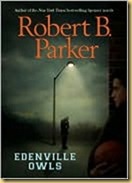 This book has it all: drama, suspense, sports, history, romance. Bobby and his friends play basketball, but since their junior high school doesn’t have a gym, they are an unofficial team –no coach, no uniforms, and they hitchhike to most of the games. When Bobby finds out there’s an extra slot in the local tournament, the Owls really get down to it. Bobby starts hanging around the high school practices to see how they practice, and he tries to get the Owls to do the same drills. The suspense comes into play with their new (and attractive) teacher, Miss Delaney. One day when Bobby is staying after school for detention, he looks out the window and sees a man threatening Miss Delaney. He scares the guy off by yelling out the window, but he just can’t let it go until he finds out who the man is and why he’s hassling Miss Delaney. The ensuing surveillance turns up Nazi connections (the book takes place just at the end of WW II), a secret marriage and a phony identity. The romance comes with Bobby’s best friend, Joanie, who Bobby maybe has more feelings for than he realized. The Owls are great friends –always there for each other, even when they clash about what to do on the basketball court or who is Joanie’s boyfriend. If you’ve read any of Parker’s adult novels about the detective Spenser, you’ll recognize his character in the young Bobby. There’s a ton of historical information inserted in separate sections of the book that really set the scene of the time period. Review by Stacy Church
This book has it all: drama, suspense, sports, history, romance. Bobby and his friends play basketball, but since their junior high school doesn’t have a gym, they are an unofficial team –no coach, no uniforms, and they hitchhike to most of the games. When Bobby finds out there’s an extra slot in the local tournament, the Owls really get down to it. Bobby starts hanging around the high school practices to see how they practice, and he tries to get the Owls to do the same drills. The suspense comes into play with their new (and attractive) teacher, Miss Delaney. One day when Bobby is staying after school for detention, he looks out the window and sees a man threatening Miss Delaney. He scares the guy off by yelling out the window, but he just can’t let it go until he finds out who the man is and why he’s hassling Miss Delaney. The ensuing surveillance turns up Nazi connections (the book takes place just at the end of WW II), a secret marriage and a phony identity. The romance comes with Bobby’s best friend, Joanie, who Bobby maybe has more feelings for than he realized. The Owls are great friends –always there for each other, even when they clash about what to do on the basketball court or who is Joanie’s boyfriend. If you’ve read any of Parker’s adult novels about the detective Spenser, you’ll recognize his character in the young Bobby. There’s a ton of historical information inserted in separate sections of the book that really set the scene of the time period. Review by Stacy Church
Thursday, April 21, 2011
Review of Flirt Club by Cathleen Daly
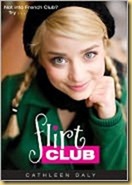 If you love Angus, Thongs and Full-Frontal Snogging, this is the book for you. Flirt Club consists mostly of letters back and forth between Isabelle and Annie (also known as Cisco and the Bean), with a few journal entries thrown in for good measure. Cisco and the Bean share the hilarious disability of being unable to flirt with boys. As Bean (Agent #66) writes to Cisco (Agent #88) “SO, I think our next undercover, secret-agent-girl operation should be learning how to FLIRT! What do you think, No. 88? …let’s see if we can adopt identities that don’t clam up, blush, stutter, sputter, and basically run away and die around boys…Write me back if you can, my little pork chop.” The writing is very funny, and of course, the voices of the two girls are much too clever to be the voices of two actual girls, but that’s ok because it’s so darn funny. At the end of the first meeting, here’s what the girls wrote:
If you love Angus, Thongs and Full-Frontal Snogging, this is the book for you. Flirt Club consists mostly of letters back and forth between Isabelle and Annie (also known as Cisco and the Bean), with a few journal entries thrown in for good measure. Cisco and the Bean share the hilarious disability of being unable to flirt with boys. As Bean (Agent #66) writes to Cisco (Agent #88) “SO, I think our next undercover, secret-agent-girl operation should be learning how to FLIRT! What do you think, No. 88? …let’s see if we can adopt identities that don’t clam up, blush, stutter, sputter, and basically run away and die around boys…Write me back if you can, my little pork chop.” The writing is very funny, and of course, the voices of the two girls are much too clever to be the voices of two actual girls, but that’s ok because it’s so darn funny. At the end of the first meeting, here’s what the girls wrote:
“In Conclusion/Things we have learned at Flirt Club:
1.Smiling,questions/showing interest are a good start. (The worst thing that can happen is that someone feels cared about.)
2. Hair flipping is not a good approach for either of us.
3. I am considering throwing things (that don’t hurt) at an ADT (Actual Designated Target).
Review by Stacy Church
Review of Rose Sees Red by Cecil Castellucci
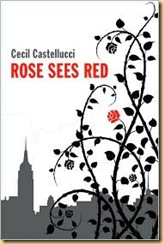 Despite a somewhat melodramatic beginning, this is a really engaging story about two teen-aged girls living in New York City: Rose, an American girl and Yrena, a Russian girl. They’ve lived next door to each other for a couple of years, and although Rose and her brother, Todd, see Yrena in the mornings (they leave for school at the same time), and Rose and Yrena have watched each other through their bedroom windows, they’ve never met until the evening Yrena climbs through Rose’s bedroom window and is suddenly there. Rose’s brother spends a lot of time fantasizing about Yrena, and they’ve both made jokes about the KGB and CIA agents who stand watch outside Yrena’s house, It’s the 1980’s, and the Cold War is on between Russia and the US. Rose goes to Performing Arts High School where she studies ballet. Yrena studies ballet also, but has no passion for it, although her dancing is brilliant. The entire book takes place in the 24 hours after Yrena comes to Rose’s house –they sneak out to join some other Performing Arts students on the steps of the Metropolitan Museum of Art because Yrena wants to go to a real American party. The funny thing is that Rose is completely withdrawn socially. She decided to go to Performing Arts HS even though her best friend, Daisy, told her their friendship was over if she didn’t go to Science with her. For once Rose stood up for herself and decided to do what she loved, which was dance. She’s so afraid of being hurt in another friendship that she makes no effort to make any friends at her new school, and it’s only because she’s trying to show Yrena a good tiime that she gets out of the house. The girls’ disappearance practically causes an international incident. Rose Sees Red opens a window into a time period not written about very often in children’s or young adult literature, and readers will probably find it hard to believe that Russia and the US were so openly distrustful of each other. Review by Stacy Church
Despite a somewhat melodramatic beginning, this is a really engaging story about two teen-aged girls living in New York City: Rose, an American girl and Yrena, a Russian girl. They’ve lived next door to each other for a couple of years, and although Rose and her brother, Todd, see Yrena in the mornings (they leave for school at the same time), and Rose and Yrena have watched each other through their bedroom windows, they’ve never met until the evening Yrena climbs through Rose’s bedroom window and is suddenly there. Rose’s brother spends a lot of time fantasizing about Yrena, and they’ve both made jokes about the KGB and CIA agents who stand watch outside Yrena’s house, It’s the 1980’s, and the Cold War is on between Russia and the US. Rose goes to Performing Arts High School where she studies ballet. Yrena studies ballet also, but has no passion for it, although her dancing is brilliant. The entire book takes place in the 24 hours after Yrena comes to Rose’s house –they sneak out to join some other Performing Arts students on the steps of the Metropolitan Museum of Art because Yrena wants to go to a real American party. The funny thing is that Rose is completely withdrawn socially. She decided to go to Performing Arts HS even though her best friend, Daisy, told her their friendship was over if she didn’t go to Science with her. For once Rose stood up for herself and decided to do what she loved, which was dance. She’s so afraid of being hurt in another friendship that she makes no effort to make any friends at her new school, and it’s only because she’s trying to show Yrena a good tiime that she gets out of the house. The girls’ disappearance practically causes an international incident. Rose Sees Red opens a window into a time period not written about very often in children’s or young adult literature, and readers will probably find it hard to believe that Russia and the US were so openly distrustful of each other. Review by Stacy Church
‘
Friday, April 8, 2011
Review of Cloaked by Alex Flinn
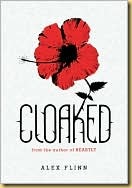 Not a lot of books can carry off a story based around a teenaged shoe repairman, but that part of the story isn’t the problem with Cloaked. I love the details about Johnny’s life running his family’s shoe repair business in a swanky hotel in Miami. Johnny’s family is poor, especially since his dad disappeared, and he’s trying to keep things going so his mom can pay the rent, and, he knows a lot about shoes. It’s not often you hear a teenaged boy talk about Manolo Blahniks. And on the sly he designs his own shoes and makes up models with the scraps of leather left over from repairs. The problem with the story comes more with the fairy tale aspect. Of course there’s a quest, with the promise of the visiting princess’s hand in marriage if he can find the frog her brother was turned into by the evil witch. The princess’s accent is tiresome. The talking swans are cool (they used to be human, so with special earbuds Johnny can understand what they’re saying). I don’t mind the travelling cloak, or how clueless Johnny is about who he really likes. But honestly, the plot is so hard to follow there were times when I went back and reread to see if I missed something that would explain what was going on. I enjoyed the first half of the book, so maybe if you’re a big fan of Alex Flinn’s other books, you can hang in there through the whole thing. Review by Stacy Church
Not a lot of books can carry off a story based around a teenaged shoe repairman, but that part of the story isn’t the problem with Cloaked. I love the details about Johnny’s life running his family’s shoe repair business in a swanky hotel in Miami. Johnny’s family is poor, especially since his dad disappeared, and he’s trying to keep things going so his mom can pay the rent, and, he knows a lot about shoes. It’s not often you hear a teenaged boy talk about Manolo Blahniks. And on the sly he designs his own shoes and makes up models with the scraps of leather left over from repairs. The problem with the story comes more with the fairy tale aspect. Of course there’s a quest, with the promise of the visiting princess’s hand in marriage if he can find the frog her brother was turned into by the evil witch. The princess’s accent is tiresome. The talking swans are cool (they used to be human, so with special earbuds Johnny can understand what they’re saying). I don’t mind the travelling cloak, or how clueless Johnny is about who he really likes. But honestly, the plot is so hard to follow there were times when I went back and reread to see if I missed something that would explain what was going on. I enjoyed the first half of the book, so maybe if you’re a big fan of Alex Flinn’s other books, you can hang in there through the whole thing. Review by Stacy Church
Review of See What I See by Gloria Whelan

Thursday, March 24, 2011
About Melissa Glenn Haber
“When I was writing The Pluto Project, for example, one of the main challenges I had in revision was making the two main female characters different from one another. While I was first writing the book, I didn’t really distinguish clearly between their characters. My editor helped me see that the two girls were really very different—one of them, Alice, was very smart, unsentimental, and a great match for the main character, Alan, while the other, Juliet (the one Alan likes) is committed, passionate, but not exceptionally bright. Once I realized my editor was right, I found lots of places where I had given Juliet dialog that really belonged to Alice, and I began to see that the brilliant ideas Juliet had really needed to come from other characters. And doing that made the book much richer, because it adds to the story that Alan (who really values wit and intelligence) should find himself attracted to someone for her passion and not for her brains. Plus, it makes the book more real, to have supporting characters who are really their own people.”
To read the full interview with the author of The Pluto Project check out her website http://www.melissaglennhaber.com/oaqs.php
Thursday, March 10, 2011
More Books about Teens as Detectives
Down the Rabbit Hole: An Echo Falls Mystery by Abrahams
Rat Life by Arnold
The Dark Days of Hamburger Halpin by Berk
The Musician's Daughter by Dunlap
The Christopher Killer: A Forensic Mystery by Ferguson
The Dying Breath: A Forensic Mystery by Ferguson
Something Rotten: A Horatio Wilkes Mystery by Gratz
Lulu Dark Can See through Walls by Madison
The Venetian Policeman by Rabb
The Death Collector by Richards
In Too Deep by Rushford
From Charlie's Point of View by Scrimger
Live and Let Shop by Spradlin
Creature of the Night by Thompson
The Uninvited by Wynne-Jones
Sunday, February 20, 2011
Review of The Big Crunch by Pete Hautman
 Reading this book reminds me of why I love Pete Hautman (author of Godless, Rash, Sweetblood). The writing is terrific: quirky, funny, believable. The Big Crunch is divided into four sections, one for each season, and it follows the relationship of Wes and June. June is the new girl at school, a role she knows all too well. Her father is a workout specialist, which isn’t what you would think –he’s hired to come in and help companies that are in trouble get out of trouble. So most of his jobs are temporary, and June’s mom and dad have a number of annoying phrases they use to try to get June on board with having to move all the time, things like, “There is no reverse gear in time machine.” Wes spends the first part of the book running away from June, who he calls Aqua Girl because of the color of her eyes. She tries to stay away from him, too, because her goal is to not get too attached to anyone. In other words, find an ok, boring, but nice, boyfriend, who in this case is Wes’s best friend, Jerry. Of course once Wes and June get together, it blows the friendship apart, and then June’s dad has to move for a new job, and she doesn’t even get to finish the year at her new high school. Hautman gets the push/pull of Wes and June’s relationship just right. One minute they’re doing crazy things so that they can be together, and the next minute they’re wondering what the heck they’re doing. Even while you root for them to work everything out, you know how unlikely it is, given all the circumstances (including their age) conspiring against them. Still, the ending is about as hopeful as you could ask for. Review by Stacy Church
Reading this book reminds me of why I love Pete Hautman (author of Godless, Rash, Sweetblood). The writing is terrific: quirky, funny, believable. The Big Crunch is divided into four sections, one for each season, and it follows the relationship of Wes and June. June is the new girl at school, a role she knows all too well. Her father is a workout specialist, which isn’t what you would think –he’s hired to come in and help companies that are in trouble get out of trouble. So most of his jobs are temporary, and June’s mom and dad have a number of annoying phrases they use to try to get June on board with having to move all the time, things like, “There is no reverse gear in time machine.” Wes spends the first part of the book running away from June, who he calls Aqua Girl because of the color of her eyes. She tries to stay away from him, too, because her goal is to not get too attached to anyone. In other words, find an ok, boring, but nice, boyfriend, who in this case is Wes’s best friend, Jerry. Of course once Wes and June get together, it blows the friendship apart, and then June’s dad has to move for a new job, and she doesn’t even get to finish the year at her new high school. Hautman gets the push/pull of Wes and June’s relationship just right. One minute they’re doing crazy things so that they can be together, and the next minute they’re wondering what the heck they’re doing. Even while you root for them to work everything out, you know how unlikely it is, given all the circumstances (including their age) conspiring against them. Still, the ending is about as hopeful as you could ask for. Review by Stacy Church
This month’s book: The Pluto Project by Melissa Glenn Haber
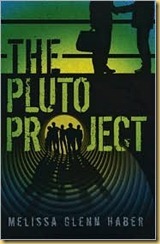 This book isn’t new, but somehow I just discovered it. 14-year-old Alan works hard at being unobtrusive (just one of the words his favorite teacher, Mrs. Perry, uses to describe him, others being misanthrope, cynic, curmudgeon), trying not to get noticed by Rory Frankel and his gang, who spend most of their time beating up Morris Kaufman, just like they have since elementary school. Alan lives in a big empty house, almost empty even of furniture, with his dad and his aunt Trish, who moved in after his mother died. Alan and his group of friends spend a lot of time hanging around in a culvert by the side of a road, listening to the conversations of passersby, and pretending to solve crimes by discovering clues to the activities of CRAP, Conspiracy Rule American People. “The whole thing had all started off as a joke. Of course it still was a joke, but not the way it had been when they’d first started the game…” In fact, Alan comes to believe it isn’t a joke at all, when he thinks they’ve heard a conversation linked to the assassination of the governor. Alan is amazing at finding meaning in lines of poetry at school, and he becomes obsessed with finding meaning in the clues he discovers in the culvert. I’ve just learned there’s a word for this: pariedolia, which means the tendency to ascribe meaning to random stimuli. Alan also becomes obsessed with the new girl at school, Juliet (“like the play), and as his obsession grows, he neglects his other friends. Alan’s home life is pretty terrible, and the pressure of his father forcing his new girlfriend, Cheryl, into Alan’s life, along with Alan’s belief that he is the only one who can stop another assassination attempt, pretty much drive him around the bend. I love everything about this book –the characters, the suspense, the sadness, Alan’s poetic interpretations. Review by Stacy Church
This book isn’t new, but somehow I just discovered it. 14-year-old Alan works hard at being unobtrusive (just one of the words his favorite teacher, Mrs. Perry, uses to describe him, others being misanthrope, cynic, curmudgeon), trying not to get noticed by Rory Frankel and his gang, who spend most of their time beating up Morris Kaufman, just like they have since elementary school. Alan lives in a big empty house, almost empty even of furniture, with his dad and his aunt Trish, who moved in after his mother died. Alan and his group of friends spend a lot of time hanging around in a culvert by the side of a road, listening to the conversations of passersby, and pretending to solve crimes by discovering clues to the activities of CRAP, Conspiracy Rule American People. “The whole thing had all started off as a joke. Of course it still was a joke, but not the way it had been when they’d first started the game…” In fact, Alan comes to believe it isn’t a joke at all, when he thinks they’ve heard a conversation linked to the assassination of the governor. Alan is amazing at finding meaning in lines of poetry at school, and he becomes obsessed with finding meaning in the clues he discovers in the culvert. I’ve just learned there’s a word for this: pariedolia, which means the tendency to ascribe meaning to random stimuli. Alan also becomes obsessed with the new girl at school, Juliet (“like the play), and as his obsession grows, he neglects his other friends. Alan’s home life is pretty terrible, and the pressure of his father forcing his new girlfriend, Cheryl, into Alan’s life, along with Alan’s belief that he is the only one who can stop another assassination attempt, pretty much drive him around the bend. I love everything about this book –the characters, the suspense, the sadness, Alan’s poetic interpretations. Review by Stacy Church
Thursday, February 10, 2011
Review of The Replacement by Brenna Yovanoff

Thursday, February 3, 2011
Is It Really Reading?
Here’s a question for you: If you read a wordless graphic novel like The Arrival, is it really reading? What does “reading” really mean, anyway? Well, here are the first four definitions of “read” according to dictionary.com
–verb (used with object)
1. to look at carefully so as to understand the meaning of (something written, printed, etc.): to read a book; to read music.
2. to utter aloud or render in speech (something written, printed, etc.): reading a story to his children; The actor read his lines in a booming voice.
3. to have such knowledge of (a language) as to be able to understand things written in it: to be able to read french.
4. to apprehend the meaning of (signs, characters, etc.) otherwise than with the eyes, as by means of the fingers: to read braille.
So I’d say yes, reading The Arrival really is reading.
Thursday, January 27, 2011
Favorite Quotes from Shaun Tan
I think stories that represent the world as hopeless or dark are valid and some of them I really enjoy but the truth is that there is hopefulness in every situation.
Drawing a good picture is like telling a really good lie – the key is in the incidental detail.
--http://www.guardian.co.uk/books/2009/jul/27/shaun-tan-unexpected-details
All fiction is false; what makes it convincing is that it runs alongside the truth.
I just find myself strongly attracted, in an empathetic way, to images of isolated figures moving through vast, often confounding landscapes.
I would go so far as to say that all art and literature is about some kind of disconnection, brokenness or discrepancy.
I'm very interested in things that are overlooked, and in trying to find value in things that are not considered valuable.
Want To Read More Books about Immigration?
Check out these titles about the immigrant experience:
Fresh off the Boat by de la Cruz
Threads and Flames by Friesner
Uprising by Haddix
Voss: How I Come to America and Am Hero, Mostly by Ives
Someone like Summer: A Novel by Kerr
Life, After by Littman
Riot by Myers
A Step from Heaven by Na
Habibi by Nye
The Night of the Burning: Devorah's Story by Wulf
Learning To Fly by Yee
Thursday, January 13, 2011
This month’s book: The Arrival by Shaun Tan
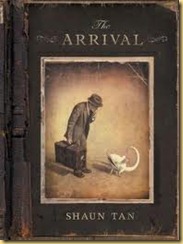 What a pleasure to come back to this book! The Arrival is a graphic novel completely without words (unless you count the ones in an imaginary language). The setting it futuristic, but the artwork is all sepia tones and distressed-looking pages. The beginning is heart-breaking: the first pictures are of household items, then a family picture, then you see the picture being wrapped and packed in a suitcase, then a picture of a wife with her hand over her husband’s hand on top of the suitcase, and it’s clear that they’re very sad. The husband tries to comfort his wife and daughter as they see him off at a train, and the wife and child return to a city overshadowed by some kind of danger, represented by a serpent-like tail. In Part II we see the man on an ocean journey with many other people. They arrive to a scene much like Ellis Island –long lines, physical exams and paperwork. Then you finally get a glimpse of the city the man has arrived in. The artwork is amazing, and clearly shows how strange and disorienting the city is for the new arrival. Many people have pets, all amazing fantastical creatures, and a particularly adorable one, who becomes his constant companion, is waiting for him in the room he rents. Part III follows the man as he tries to find work. He encounters people who help him, and each of their stories is told in a series of images. Most of the people are fleeing terrible things. In Part IV he tries a few jobs, and is told more personal stories of other immigrants. In Part V he sends for his family, who come to join him in the new land. The books ends with his daughter passing on to a new arrival the kindness shown to her father when he arrived in the new land. There are parts of the book I don’t understand (what is the dragontail menacing his old land?), but some things I understand better as I read the book over again. The Arrival conveys the new immigrant’s bewilderment at his new surroundings better than any book with words ever could. Review by Stacy Church
What a pleasure to come back to this book! The Arrival is a graphic novel completely without words (unless you count the ones in an imaginary language). The setting it futuristic, but the artwork is all sepia tones and distressed-looking pages. The beginning is heart-breaking: the first pictures are of household items, then a family picture, then you see the picture being wrapped and packed in a suitcase, then a picture of a wife with her hand over her husband’s hand on top of the suitcase, and it’s clear that they’re very sad. The husband tries to comfort his wife and daughter as they see him off at a train, and the wife and child return to a city overshadowed by some kind of danger, represented by a serpent-like tail. In Part II we see the man on an ocean journey with many other people. They arrive to a scene much like Ellis Island –long lines, physical exams and paperwork. Then you finally get a glimpse of the city the man has arrived in. The artwork is amazing, and clearly shows how strange and disorienting the city is for the new arrival. Many people have pets, all amazing fantastical creatures, and a particularly adorable one, who becomes his constant companion, is waiting for him in the room he rents. Part III follows the man as he tries to find work. He encounters people who help him, and each of their stories is told in a series of images. Most of the people are fleeing terrible things. In Part IV he tries a few jobs, and is told more personal stories of other immigrants. In Part V he sends for his family, who come to join him in the new land. The books ends with his daughter passing on to a new arrival the kindness shown to her father when he arrived in the new land. There are parts of the book I don’t understand (what is the dragontail menacing his old land?), but some things I understand better as I read the book over again. The Arrival conveys the new immigrant’s bewilderment at his new surroundings better than any book with words ever could. Review by Stacy Church




